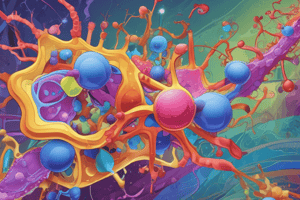Podcast
Questions and Answers
What is the role of HLA proteins?
What is the role of HLA proteins?
The role of HLA proteins is to present 'peptide antigens' to the immune system, enabling recognition of non-self antigens and development of immune responses.
Where are MHC-I proteins expressed?
Where are MHC-I proteins expressed?
MHC-I proteins are expressed ubiquitously on all nucleated cells in the body for the presentation of intracellular self/non-self antigens.
How are classical MHC-I proteins split?
How are classical MHC-I proteins split?
Classical MHC-I proteins are split into HLA-A, HLA-B, and HLA-C subtypes.
What are the differences between classical and non-classical MHC-I molecules?
What are the differences between classical and non-classical MHC-I molecules?
To which class does HLA-G belong?
To which class does HLA-G belong?
How many isoforms of HLA-G are encoded by the same primary mRNA?
How many isoforms of HLA-G are encoded by the same primary mRNA?
What are the four isoforms of HLA-G that are membrane-bound?
What are the four isoforms of HLA-G that are membrane-bound?
Which isoforms of HLA-G are released as soluble molecules?
Which isoforms of HLA-G are released as soluble molecules?
Name three types of cells that HLA-G can directly suppress the function of.
Name three types of cells that HLA-G can directly suppress the function of.
What is the role of HLA-G at the maternal-fetal interface?
What is the role of HLA-G at the maternal-fetal interface?
In transplanted patients, how may an increased expression of surface HLA-G and an augmented concentration of serum sHLA-G protect the transplanted organs?
In transplanted patients, how may an increased expression of surface HLA-G and an augmented concentration of serum sHLA-G protect the transplanted organs?
What is the pathological role of HLA-G expression on transformed cells?
What is the pathological role of HLA-G expression on transformed cells?
What is the function of HLA-E in immune surveillance?
What is the function of HLA-E in immune surveillance?
What is the requirement for the surface expression of HLA-E?
What is the requirement for the surface expression of HLA-E?
Which NK receptors does HLA-E bind to?
Which NK receptors does HLA-E bind to?
Which molecules does HLA-E bind peptides derived from?
Which molecules does HLA-E bind peptides derived from?
Flashcards are hidden until you start studying




